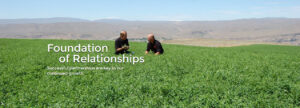Looking for Clues about Equine Health
The bacterial population in the gastrointestinal tracts of animals directly affects energy metabolism, digestive capability, development of the gut immune system, and disease. This is especially true in horses, animals that rely upon bacteria to ferment roughages into useful sources of nutrition. A better understanding of the equine gut microbial population is therefore a key factor in discerning equine nutritional needs and is especially important in comprehending how gut microbes affect equine health.

The diversity of the microbial population in the horse gastrointestinal system is affected by age, diet, and previous exposure (microbes are introduced into the gut after consumption). Maintenance of the balance of microbial species in the equine gut is important to avoid digestive system upset. This is the main reason why dietary changes should be made slowly. Rapid changes in diet, such as changing from a 100% alfalfa hay diet to a high-grain diet, will often be detrimental to “good” hindgut bacteria and beneficial to “bad” bacteria. In other words, the abrupt increase in starch or nonstructural carbohydrates following over-consumption of grain or lush cool-season grasses, respectively, will induce fermentation that produces lactic acid and gas, which can cause colic and laminitis in horses.
The equine hindgut microflora is very diverse. Scientists believe that less than 5% of all microbial species in the equine gut have been identified to date. Interestingly, bacterial species are different in stabled versus pastured-horses, and previous studies indicate that certain species of bacteria are more prevalent during episodes of some equine diseases.
How changes in equine gut bacterial diversity affects diseases such as laminitis has yet to be discovered. Fortunately, advances in next-generation sequencing (NGS) technology has allowed for more rapid and reliable discovery of bacterial species and determination of their functions in the guts of animals. A group of scientists from Texas A&M University recently examined the microbial species in guts of ten healthy horses and eight horses with chronic laminitis to determine if there was a link between equine bacterial populations and laminitis. Since the majority of bacterial DNA in the gastrointestinal tract is shed in feces, they used NGS methods to identify microbial DNA in fecal samples collected from both groups of horses. They found that there was large individual variation in bacterial communities in feces of each horse, which may have been affected by the genetic background, age, and body condition of each horse, as well as diet and time of feeding. As expected, there was a high abundance of cellulolytic bacteria (bacteria that can break down plant structural carbohydrates) as well as a large number of previously uncharacterized bacteria. Interestingly, horses with chronic laminitis had higher bacterial diversity than control horses. In addition, they also found that two unknown species of bacteria were more numerous in laminitic horses. These exciting data provide a promising foundation for the study of hindgut bacterial factors that may cause laminitis to develop and progress.
To receive this blog from Anderson Hay directly in your email, please subscribe above to the right.
Reference
Steelman, S.M., B.P. Chowdhary, S. Dowd, J. Suchodolski, and J.E. Janecka. 2012. Pyrosequencing of 16S rRNA genes in fecal samples reveals high diversity of hindgut microflora in horses and potential links to chronic laminitis. BMC Vet. Res. 8:231-241.


